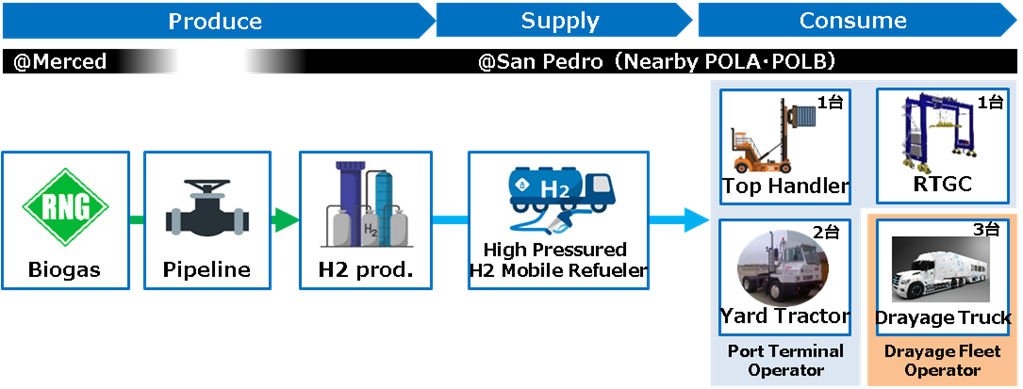Toyota Tsusho to Start the World’s First Long-term Implementation Demonstration Project for the Local Production for Local Consumption of Hydrogen at the Port of Los Angeles in the United States
In December 2021, the New Energy and Industrial Technology Development Organization (“NEDO”) awarded its grant to Toyota Tsusho Corporation (“Toyota Tsusho”) and Toyota Tsusho America Inc. (“TAI”) for a technology development project for establishing a hydrogen-based society entitled “Demonstration project for the commercialization of the port hydrogen model at the Port of Los Angeles in North America.” To this end, the two companies will commence an implementation demonstration project (“the project”) on the use of hydrogen fuel cell (“FC”) to power port container handling equipment and drayage trucks*1, and the local production of hydrogen for local consumption specifically at the ports. The project is taking place at the Port of Los Angeles (“POLA”), California, U.S.A. This project is scheduled to be implemented from February 2022 to March 2026 in collaboration with four companies: Mitsui E&S Machinery Co. Ltd., PACECO CORP., Hino Motors, Ltd., and Hino Motor Manufacturing U.S.A., Inc.
Background
The U.S. government has set a goal to reduce greenhouse gas (“GHG”) emissions by 50% to 52% of the level in 2005 by 2030, and achieve carbon neutrality by 2050. In terms of the GHG emissions by business sector, the transportation sector including ports makes up about 30%*2, and GHG emissions reduction as well as the use of low-carbon and decarbonized energies are strongly required.
At POLA, the largest port in the U.S., and the Port of Long Beach (“POLB”), which is adjacent to POLA, concerted efforts to reduce GHG emissions from the cargo handling operations at these ports are being implemented with the aim of achieving zero emissions (“ZE”) for port cargo handling equipment by 2030 and drayage trucks by 2035. At POLA and POLB, progress has been made in the battery-electrification of small equipment such as forklifts; however, battery-electrification of larger port equipment including top handlers faces constraints such as their long operating hours and limited time for charging as well as the lack of charging infrastructure at the ports. On the other hand, FC is regarded as a promising alternative to existing diesel-powered equipment, since it would enable both continuous operation through shift hours and quick refueling during short downtime.
The Project
Toyota Tsusho and TAI will carry out this project in collaboration with the project partners as the follow-on project of NEDO’s research project entitled “An investigation into the potential production and use of hydrogen based on a local production for local consumption model,” which started in September 2020. This is the world’s first project to implement and demonstrate FC-powered port equipment and drayage trucks as well as hydrogen production/supply equipment for a long period of around three years in a real operating environment.
Overview of the Demonstration Project
- Long-term operation of FC-powered port equipment and drayage trucks entering and exiting ports in a real operating use environments
Top handlers, RTGCs (Rubber-Tired Gantry Cranes), yard trucks (vehicles moving containers around freight yards), and drayage trucks will be powered by FC. These types of port equipment and hydrogen refueling equipment will be operated in real operating environments and data on their operations including equipment operating time will be collected and analyzed. - Long-term operation of hydrogen production/supply equipment specialized for ports by building a supply chain for local production of hydrogen for local consumption
TAI invested in Merced Pipeline LLC which produces and sells renewable natural gas (“RNG”) from dairy manure in April 2021 and commenced operations in December 2021. Supposing that this RNG is reformed to produce hydrogen, and through the development and introduction of hydrogen production equipment and mobile high-pressured hydrogen refueler, the hydrogen supply method that maintains the current operation of the port terminal and drayage trucks will be verified.
Through this project, we plan to establish a ZE solution using hydrogen at ports and consider business development for the use of hydrogen for large equipment that is difficult to convert to battery-electrification in Japan.
Toyota Tsusho Group will contribute to the transition to a decarbonized society by accelerating businesses that contribute to GHG emissions reduction throughout the industrial life cycle and promoting carbon neutral initiatives.
Implementation Demonstration

*1 Drayage truck
Truck that handles overland freight of cargo transported by container
*2 Source: United States Environmental Protection Agency
https://www.epa.gov/ghgemissions/inventory-us-greenhouse-gas-emissions-and-sinks
Our Efforts So Far
- Toyota Tsusho to Conduct Feasibility Study into Local Production for Local Consumption of Hydrogen – Seeking to use fuel cells to large-scale machinery at the Port of Los Angeles – dated October 14, 2020. (https://www.toyota-tsusho.com/english/press/detail/201014_004696.html)
- Toyota Tsusho Invests in Merced Pipeline LLC Which Manufactures and Sells Renewable Natural Gas in the United States – Contributing to the transition to a decarbonized society by building hydrogen manufacturing value chain – dated July 12, 2021. (https://www.toyota-tsusho.com/english/press/detail/210712_004864.html)

